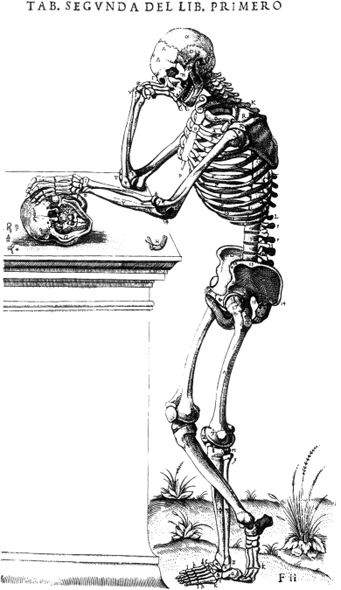

Renaissance anatomical illustrations often followed artistic conventions (situating the skeleton in a lifelike pose in a landscape) and played wittily on the tensions between life and death. The contemplation of the skull prefigures Hamlet’s later meditation. Line drawing, Valverde de Hamusco, Historia de la composicion del cuerco humano (Rome: A. Salamanca & A. Lafreri, 1556).

TO
Mikuláš Teich,
true friend and scholar
Sick – Sick – Sick. . . O Sick – Sick – Spew
DAVID GARRICK, in a letter
I’m sick of gruel, and the dietetics,
I’m sick of pills, and sicker of emetics,
I’m sick of pulses, tardiness or quickness,
I’m sick of blood, its thinness or its thickness, –
In short, within a word, I’m sick of sickness!
THOMAS HOOD, ‘Fragment’, c. 1844
They are shallow animals, having always employed their minds about Body and Gut, they imagine that in the whole system of things there is nothing but Gut and Body.
SAMUEL TAYLOR COLERIDGE, on doctors (1796)
CONTENTS
The four humours and the four elements
The heart and circulation, as understood by Harvey
Neurones and synapses, as understood by neurologists c. 1900
Portrait of Galen by Georg Paul Busch.
Portrait of Hildegard of Bingen by W. Marshall.
Portrait of Moses Maimonides by M. Gur-Aryeh.
The Wound Man, from Feldtbuch der Wundartzney by H. von Gersdorf.
The common willow, from The Herball, or General Historie of Plantes by J. Gerard.
St Cosmas and St Damian performing the miracle of the black leg by Alonso de Sedano.
A medieval Persian anatomical drawing.
A medieval European anatomy, from Margarita Philosophica by Gregorius Reisch.
‘Two Surgeons Amputating the Leg and Arm of the Same Patient’ by ZS.
The frontispiece to Vesalius’s De humani corporis fabrica.
An Indian doctor taking the pulse of a patient.
Portrait of William Harvey by J. Hall.
Portrait of William Hunter by J. Thomas.
Portrait of Benjamin Rush by R. W. Dodson.
An early seventeenth-century dissection.
Scenes from the plague in Rome of 1656.
A mother and baby, from Anatomia uteri humani gravidi by William Hunter. Three stages of dissection.
Opthamology instruments, eye growths, a cateract operation and other eye defects by R. Parr.
The preserved skull of a woman who had been suffering from syphilis.
Punch Cures the Gout, the Colic, and the Tisick by James Gillray.
An Apothecary with a Pestle and Mortar to Make up a Prescription by A. Park.
The interior of a pharmaceutical laboratory with people at work.
Philadelphia College of Pharmacy and Science.
Portrait of René Théophile Hyacyinthe Laennec
Portrait of Louis Pasteur by E. Pirou.
Christiaan Barnard, photographed by B. Govender.
Mentally ill patients in the garden of an asylum by K. H. Merz.
Sigmund Freud, Carl Gustav Jung, Ernest Jones, Sandor Ferenczi, Abraham
A male smallpox patient in sickness and in health.
A Fijian man with elephantiasis of the left leg and scrotum.
An Allegory of Malaria by Maurice Dudevant.
Portrait of Florence Nightingale.
A Nurse Checking on a Playful Child by J. E. Sutcliffe.
‘A district health centre where crowds of local children are being vaccinated’ by E. Buckman.
Lister and his assistants in the Victoria Ward.
A British hospital ward in the 1990s photographed by Emma Taylor.
The bones of a hand, with a ring on one finger, viewed through X-ray.